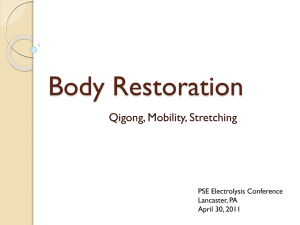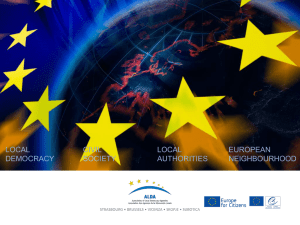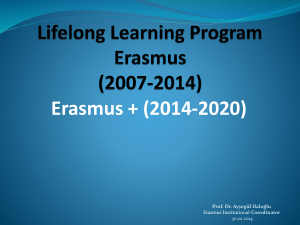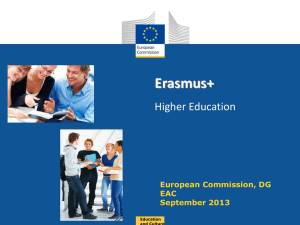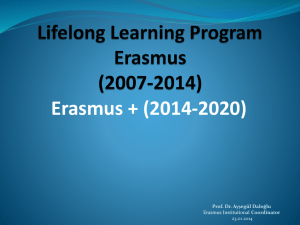PPT - Office of the Higher Education Commission
advertisement
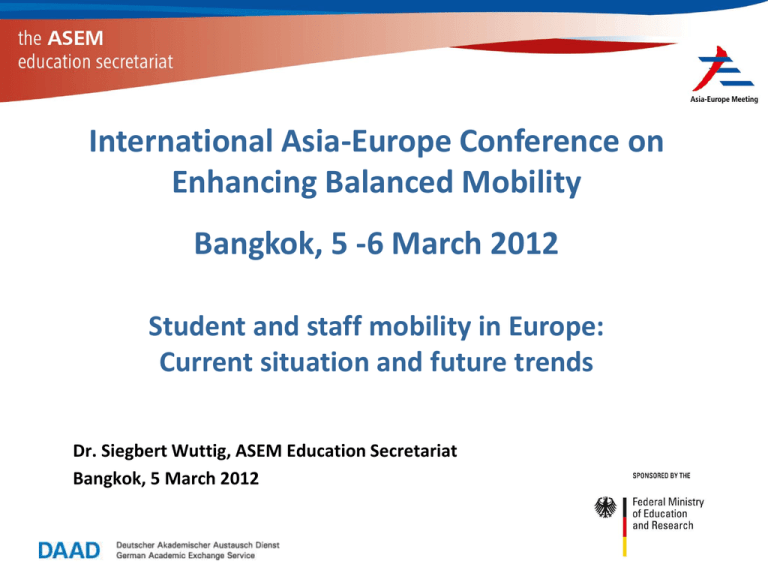
International Asia-Europe Conference on Enhancing Balanced Mobility Bangkok, 5 -6 March 2012 Student and staff mobility in Europe: Current situation and future trends Dr. Siegbert Wuttig, ASEM Education Secretariat Bangkok, 5 March 2012 DAAD – Facts and Figures 2011 The DAAD has... The DAAD is... • an annual budget of 384 million euros ( = US$ 558 million) • Internationalisation agency for German higher education institutions • almost 800 staff • ASEM Education Secretariat • 64 Regional Offices and Information Centres (IC) all over the world • National Agency for EU Higher Education Cooperation • 475 DAAD Lecturers • 106.000 DAAD and ERASMUS scholarship holders p.a. • around 600 professors on 90 selection committees • National IAESTE Secretariat (traineeships and internships) • (Co-)responsible for the Marketing Consortium GATE • (Co-)responsible for the TestDaF Institut 2 Student mobility: policies and targets at European level EU Policies LLP/ERASMUS *Increasing mobility: 3 million target, i.e. 282,000 p.a. in 2012 *More joint programmes *Improving recognition Youth on the Move Mobility for all by 2020 Bologna Process Leuven/Louvain-la-Neuve *Increasing mobility: 20% by 2020 *achieving a more balanced mobility in the EHEA *increasing the number of joint programmes *creating flexible curricula *improving recognition EU mobility benchmark At least 20% by 2020 (study or placement period abroad) *encouraging linguistic pluralism National Agency for EU Higher Education Cooperation 3 Student mobility: policies and targets at national and institutional level National Policies Institutional Policies National targets Institutional targets DE: Increasing mobility rate for outgoing students to 50 % in the medium term University of Glasgow: Increasing number of outgoing students in mobility programmes by appr. 30%, i.e. from 1.100 to 1.300 in the years 2007 to 2010 DE: Increasing mobility rate for incoming students to 10 – 15 % , i.e. 300.000 p.a. by 2012 National Agency for EU Higher Education Cooperation 4 Selected European policy agendas including higher education Europe 2020 Bologna Process Copenhagen Process New Transatlantic Agenda Neighbourhood Policy Neighbourhood Policy Eastern Partnership Initiative Asia-Europa Meeting ASEM Union for the Mediterranean EU-Latin America Partnership Africa-EU Strategic Partnership EU-Australia Partnership Framework 5 EU Higher education programmes - worldwide NORTH AMERICA •ATLANTIS (EU-USA) •TEP (EU-Canada) •Erasmus Mundus II EUROPE •Tempus IV •Erasmus Mundus II NORTH AFRICA / MIDDLE EAST •Tempus IV •Erasmus Mundus II •Intra-ACP Academic Mobility Scheme LATIN AMERICA •ALFA III •Erasmus Mundus II ASIA •Tempus IV •Erasmus Mundus II •EU-Japan/Korea Programme •ASEM-Duo •Vulcanus (Japan) •AFRICA / CARRIBEAN / PACIFIC •EDULINK •ACP Science and Technology Programme •Erasmus Mundus II •Intra-ACP Academic Mobility Scheme OCEANIA •EU-Australia/New Zealand Programme •Erasmus Mundus II 6 The European Higher Education Area: 47 signatory countries 1999 - 2010 1999 (Bologna: 30) Austria, Belgium, Bulgaria, Czech Republic, Denmark, Estonia, Finland, France, Germany, Greece, Hungary, Iceland, Ireland, Italy, Latvia, Liechtenstein, Lithuania, Luxembourg, Malta, Netherlands, Norway, Poland, Portugal, Romania, Slovak Republic, Slovenia, Spain, Sweden, Switzerland, United Kingdom 2001 (Prague: 33) Croatia, Cyprus, Turkey 2003 (Berlin: 40) Albania, Andorra, BosniaHerzegovina, Holy See, FYR of Macedonia, Russia, Serbia Kazakhstan 2005 (Bergen: 45) Armenia, Azerbaijan, Georgia, Moldova, Ukraine 2007 (London: 46) Montenegro 2010 (Vienna: 47) Kazakhstan Bologna H.E. Area 7 The „Bologna Revolution“ 1988/1999 - 2010 Bologna 1988/1999 Leuven/Louvain-la Neuve 2009 Budapest/ Vienna 2010 Bologna Magna Charta Dr. Wuttig 06/10 8 Main topics of the Bologna Process 1999 - 2010 Benchmark of 20 % by 2020 for student mobility National Qualifications Frameworks by 2012 Promoting Mobility student/staff National targets for the Social Dimension to be measured by 2020 Reinforce Social Dimension LLL as a public responsibility requiring strong partnerships Call to work on employability Availability of Data Continuing implementation of Bologna tools Improve Employability Quality as an overarching focus for EHEA Strategy adopted for the EHEA in a global setting Enhance global Policy dialogue through Bologna Policy Fora 2009 Leuven Communiqué Quelle: Eurydice 9 The Bologna Process: How does it work? Bologna Secretariat Ministerial Conferences Leuven 2009 –Budapest/Vienna 2010- Bucarest 2012 Bologna Follow-Up Group 7 Working Groups, 4 Networks (e.g. WG Mobility) Bologna Conferences, Seminars, Workshops 10 Dr. Wuttig 06/10 10 Bologna Stocktaking Reports 2009/2010 1. Rauhvagers, A. et al., Bologna Process Stocktaking Report, Leuven/Louvain-la-Neuve 2009 2. CHEPS, INCHER, ECOTEC, The Bologna Process Independent Assessement – The first decade of working on the European Higher Education Area, Brussels 2010 3. Sursock, A., Smidt, H., Trends 2010: A decade of change in European Higher Education, EUA: Brussels 2010 4. EACEA/Eurydice, Focus on Higher Education in Europe 2010: the impact of the Bologna Process, Brussels 2010 Dr. Wuttig 06/10 11 Dr. Wuttig 06/10 12 Stocktaking Report Leuven 2009: Scorecard Bologna countries Two- cycle- structure in the EHEA 2008/09 240 + 120 ECTS 240 + 60 ECTS 180 + 120 ECTS Various combinations No Master programmes Not available Source: Eurydice Dr. Wuttig 06/10 13 Level of ECTS implementation in the EHEA 2008/09 75 % + using ECTS based on learning outcomes and student workload 75 % + using ECTS based on student workload 75 % + using ECTS based on contact hours, or contact hours & student workload 75 % or less using ECTS with variety of credit definitions National credit systems in parallel. ECTS mainly used for transfer Source: Eurydice Dr. Wuttig 06/10 14 Student mobility in the EHEA Incoming student mobility Outgoing student mobility 6-10 % 10 % + Data not available Source: Eurydice 2009 Data: Eurostat 2006 Dr. Wuttig 06/10 15 Implementation of National Qualifications Frameworks 2008/09 Stand: 2009 Quelle: Eurydice Dr. Wuttig 06/10 16 Lifelong Learning Programme (2007 – 2013) Lifelong Learning Programme 2007 - 2013 Budget: 6.97 billion € (Proposal: 13.620 billion €) Min. 13 % Min. 40 % Min. 25% Min. 4% School Education Higher Education Vocational Education Adult Education COMENIUS ERASMUS LEONARDO DA VINCI GRUNDTVIG 3.1 billion € for 7 years 3.1 billion € Transversal Programmes Jean Monnet - Political development - Languages - ICT - Dissemination 17 ERASMUS Student mobility: 1987/88 – 2009/10 Erasmus student mobility 1987/88 - 2009/10 250.000 213.266 number of students per year 200.000 150.000 100.000 50.000 3.244 0 18 Erasmus Student Mobility: 2008/09 => 2009/10 198 523 => 213 266 mobile students (+7.43%) 4502 => 7053 zero-grant students (+56.66%) 2658 => 2853 HEIs sent students on mobilities Top sending countries: ES, FR, DE Top host countries: ES, FR, UK, DE Average Duration: 6.1 => 6.04 months Average Grant: 272 € => 254 € (-6.62%) Gender balance: 60.7 % => 61.1 % females Source: European Commission 19 19 (Im)balances in Erasmus student mobility flows Source: European Commission 20 Global student mobility: inward and outward United States China United Kingdom France Germany OUT IN Australia Canada India Japan Korea Malaysia Ireland (600,000) (400,000) (200,000) - 200,000 400,000 600,000 800,000 Quelle: UIS and Project Atlas (IIE) 21 Mobility in Erasmus Mundus Action 1 (2004-2011) Joint Masters and Doctoral Programmes NORTH AMERICA EUROPE (EU) • 572 MA • 14 PhD • 2.710 MA (1.343) • 144 PhD (101) ASIA • 4.969 MA • 92 PhD NORTH AFRICA / MIDDLE EAST • 475 MA • 24 PhD LATIN AMERICA • 1.789 MA • 43 PhD AFRICA / CARIBBEAN / PACIFIC • 1.369 MA • 23 PhD OCEANIA • 150 MA • 6 PhD 02/2012 22 Student mobility DE - Asian ASEM countries: DAAD scholarships 5,135 Asia 3,747 ASEM Asian nationals Australia/New Zealand German nationals 210 Oceania 1,028 02/2012 23 Staff mobility DE - Asian ASEM countries: DAAD scholarships 1,052 1,192 Asia ASEM Asian nationals Australia/New Zealand German nationals 35 Oceania 239 02/2012 24 ERASMUS staff mobility: 2008/09 => 2009/10 270.000 staff exchanges since 1997 36 389 => 37 525 mobile staff (+3.12%) 1214 => 1484 Number of active HEIs (+22.24%) Top sending countries: PL, ES, and DE Top host countries: DE, ES and IT Average duration: 5.6 => 5.8 days Average grant: 684.5 € => 672 € (-1.8%) Gender balance: 60.2% => 53.1% male Source: European Commission 25 (Im)balances in ERASMUS staff mobility flows Source: European Commission 26 Main obstacles to student mobility in the EHEA 35 30 25 20 Incoming mobility 15 Outgoing mobility 10 5 0 Source: BFUG working group on mobility Dr. Wuttig 06/10 27 Main obstacles to staff mobility in the EHEA 30 25 20 Incoming mobility 15 Outgoing mobility 10 5 0 Immigration restrictions Recognition issues Language issues Incompatibility of pension and/or social security systems Legal issues Other Source: BFUG working group on mobility Dr. Wuttig 06/10 28 Balanced mobility? 4 6 Yes No No or no clear answer 30 Balanced mobility in: CZ, BE (fl.), FI, IS, NL, SLO Source: BFUG working group on mobility Dr. Wuttig 06/10 29 Imbalances with countries and regions • Tendency to go to English-speaking countries (for credit and degree mobility); • Increasing numbers of incoming students from Eastern European and Asian countries; • High fluctuation between neighbouring countries and/or countries sharing a common language; • Non-EU EHEA countries have a strong imbalance towards EU Member States; Only one-third of EHEA countries address the issue of balanced mobility in their mobility strategies (e.g. Denmark, Netherlands, Poland). And: For some countries, imbalances are of particular concern (e.g. Armenia), for others not (e.g. UK). Dr. Wuttig 06/10 30 Student mobility and imbalances: challenges Country level: 1. Significant outward degree mobility: brain drain? 2. Significant inward degree mobility: cost-covering fees or compensation payments? Institutional level: 1. Significant inward mobility: sufficient absorption capacity of institutions? 2. Significant mobility imbalances: reasons and solutions? Dr. Wuttig 06/10 31 Student mobility and imbalances: solutions To stimulate outward student mobility: • Offer grant schemes • Guarantee recognition (learning agreements) • Offer good preparation and monitoring of stays abroad • Provide information and improve motivation • Implement mobility-friendly curricula To stimulate inward student mobility: • Offer grant schemes • Provide information on host country and institution (promotion) • Offer attractive study programmes and student placements • Implement study programmes taught in English Specific measures to achieve a more balanced mobility: • Reciprocal exchanges based on bilateral agreements • Joint programmes • Return schemes for degree students/doctoral candidates Dr. Wuttig 06/10 32 The future: Erasmus for all (2014- 2020) Existing programmes A single integrated programme Budget: 19 billion Euro (+73 % ?) Lifelong Learning Programme: International higher education Programmes (currently Erasmus Mundus, Tempus, Alfa, Edulink) Grundtvig Erasmus Leonardo Comenius Youth in Action Programme Erasmus for all 1. Learning Mobility 3. 2. Policy Institutional co-operation support With specific chapters for: • Jean Monnet Actions • Sport Source: European Commission Dr. Wuttig 06/10 33 www.asem-education-secretariat.org

